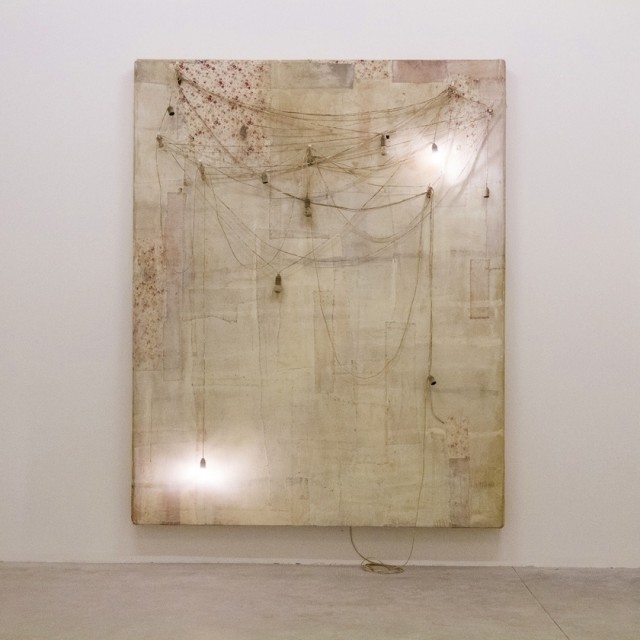Per_forming a collection #3 is the new event that extends and continues the project devoted to the progressive establishment of the museum’s permanent collection, and presents historical works and new commissions from Italian and international artists of different generations.
This further chapter confirms the organic identity of the Madre’s collection, its gradual emergence pervading the museum’s policy of exhibition, research and education, as well as the historical perspective and immersion in the most recent artistic production, suggesting a polyphonic narrative, shared with the artists and the public, which investigates the history, or rather “histories,” of contemporary art in Naples and Campania, in their dynamic relation to international developments.
The artists presented in the context of Per_forming a collection #3 are: Francis Alÿs, Antonio Biasiucci, Lawrence Carroll, Roberto Cuoghi, Giulio Delve’, John Henderson, Shirin Neshat, Mimmo Paladino, Mario Schifano, Pádraig Timoney. The works of these artists are integrated within the exhibition delineated by the previous chapters of the ongoing project Per_forming a collection (Per_ forming a collection #1, which opened on June 21, 2013, Per_forming a collection #2, which opened on December 20, 2013 and Per_forming a collection (Intermezzo), which opened June 13, 2014).
The photographic work of Shirin Neshat is presented within the exhibition formed in the course of the preceding chapters of the project, in the room dedicated to relations between gesture, sign and language, and is set in relation to works by two Italian artists of different generations and aesthetics, Maria Lai and Tomaso Binga, but united with the Iranian artist by the intertextual use of the word in its ambivalent and polysemic relation with the image, and by the penetrating exploration of the relations between male and female sensibility.
Similarly, combined in the collection with works by Alighiero Boetti and Mario Garcia Torres, presenting reflections by artists of different generations and sensibilities, but united by the intense experience of the reality of Afghanistan, past and present, the exhibition layout presents REEL-UNREEL and Children’s Game #7, two of Francis Alÿs’ most representative videos. These works, part of the Afghan Projects produced by Alÿs between 2010 and 2014, render an intimate and personal vision of contemporary Afghanistan capable of subverting the media image the Western public has of it.
The exploration of the spheres of sculpture and painting is undertaken in this new chapter by several works, which join those by Tony Cragg (second courtyard), Francesco Clemente, Mark Manders and Marisa Merz, presented in the previous chapter Per_forming a collection (Intermezzo), such as the four paintings – taken together a veritable environmental work – by Lawrence Carroll, which reconstructs the artist’s room in the first Vatican Pavilion at the 55th Venice Biennale (2013).
At the point of intersection between photography and archives, the work of Antonio Biasiucci starts from photography and gains the dimensions of an installation, configured as a veritable archive of personal memories in miniature, becoming a reflection on the relations between photography and memory, intimacy and the public dimension. The work, presented at the second floor of Palazzo Donnaregina, is related to a second installation on the roof terrace of the museum, whose images will vary depending on the incidence of the sun’s rays.
In the same gallery, the large canvas by Mimmo Paladino evokes a representation that combines varied iconographic elements, the expressions of a primordial and archetypal dimension of painting: a row of hands, bleeding or marked by stigmata, and other objects are arranged in the space of the canvas and reference a universal language, an ancestral proxemics rooted in popular culture, but also personal memories, ancient myths, archaic rituals, alchemical practices, quotations from art history and the religious tradition of ex-voto, which have deep cultural roots in Naples and Campania, to the emotional and intellectual synthesis of Byzantine icons.
The walkthrough of Per_forming a collection #3 comes to an end on the second floor with the works, suspended between abstraction and figuration, monochrome and multi-chromatic evocations, by Roberto Cuoghi, John Henderson and Pádraig Timoney, beside Mario Schifano, with one of the most representative works of his “Futurist” period, a personal tribute to Giacomo Balla, and his studies of the repetitive trend of movement in sequences.
Per_ forming a collection #3 includes the commission of a site- specific work by the young Neapolitan artist Giulio Delve’, who intervened by subtly interpreting the recreational and community function of the place, in the cafeteria lounge on the first floor of the museum.
Defining an experience of the museum as a living organism, consisting not only of physical spaces but also of social and symbolic relations, of stories to be told and new possibilities to be configured, Per_forming a collection #3 once again confirms its twofold vocation, both “historical” and “purposeful”, and the “narrative”, “performative,” and therefore dynamic and constantly evolving matrix which underlies the construction of the Madre’s collection.
